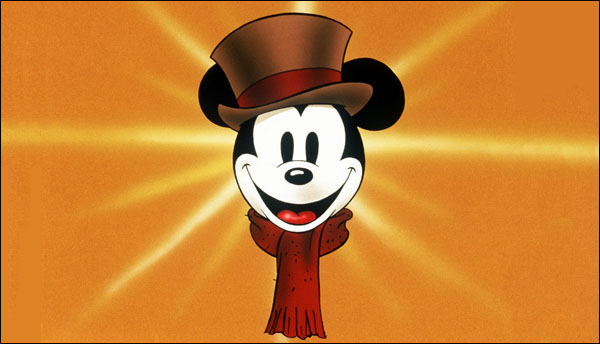
Suspended Animation #299
At this holiday time of year, one of the Disney cartoons that always gets shown is Mickey’s Christmas Carol (1983). It was the first theatrical film to feature Mickey Mouse in thirty years since the release of The Simple Things (1953) and the last time Clarence Nash voiced Donald Duck.
After its theatrical release attached to a December 1983 re-release of the Disney animated feature The Rescuers (1977), Mickey’s Christmas Carol has been seen on ABC, NBC, CBS, The Disney Channel, Toon Disney and ABC Family (now Freeform). In addition, it has been released multiple times to various home video formats. The shot of Mickey Mouse holding Tiny Tim’s crutch is seen in the opening of the videogame Epic Mickey.
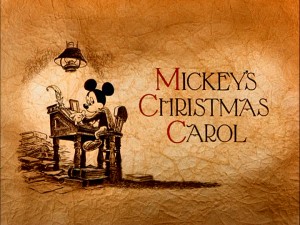 Storyman Burny Mattinson had always wanted to do a film featuring all of the Fab Five (aka “The Standard Characters”, Mickey, Minnie, Donald, Goofy, Pluto) and he was familiar with a 1975 Disneyland Storyteller Record album titled An Adaptation of Dickens’ Christmas Carol Performed by the Walt Disney Players written by Alan Young who also performed as Uncle Scrooge and Merlin, Mickey Mouse and Tiny Tim.
Storyman Burny Mattinson had always wanted to do a film featuring all of the Fab Five (aka “The Standard Characters”, Mickey, Minnie, Donald, Goofy, Pluto) and he was familiar with a 1975 Disneyland Storyteller Record album titled An Adaptation of Dickens’ Christmas Carol Performed by the Walt Disney Players written by Alan Young who also performed as Uncle Scrooge and Merlin, Mickey Mouse and Tiny Tim.
Burny sent it to CEO Ron Miller, along with his suggestions to make it a half hour animated special. Miller thought it was a great idea and gave Mattinson the approval to produce and direct the project. It was Mattinson’s first directorial assignment, but was so successful he later went on to co-direct The Great Mouse Detective (1986).
The animators included Glen Keane, who drew Willie the Giant (as well as some scenes with Scrooge and Goofy) and used the movement of his 18-month-old child as an inspiration; Mark Henn concentrated on Mickey Mouse.
Ed Gombert worked on Donald Duck, Ratty and Mole (and whose work on the last two characters earned him praise from Disney Legends Frank Thomas and Ollie Johnston who had originally animated the pair); David Block focused on Scrooge (making him in design much like Ludwig von Drake); Randy Cartwright did the work on Goofy (but also worked on the Daisy and Scrooge scene) and Dale Baer and his wife Jane’s work included Scrooge’s visit to the graveyard with the Ghost of Christmas Future.
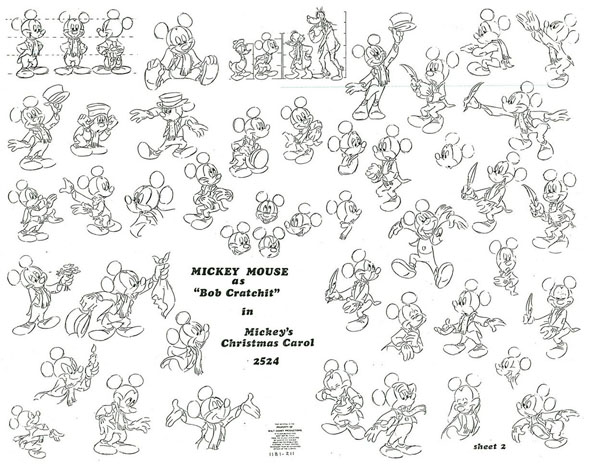
The very talented Michael Peraza, who among other things designed the distinctive title cards, added some story and staging ideas for the graveyard scene, including charcoal sketches that started as a silhouette of Pete and then had him lit by the light of his cigar. That bit of business became controversial and the subject of much discussion because a Disney character, even a villain, was smoking on screen and it was almost cut.
Peraza was given one of the door knockers used in the Bank of England set in Mary Poppins (1964) to use as reference for Scrooge’s door knocker that transforms into the face of Jacob “Goofy” Marley. Peraza also built various set models (counting house, Mickey’s desk, Scrooge’s desk, Scrooge’s stairway and his bedroom) to be used as physical references for the animators.
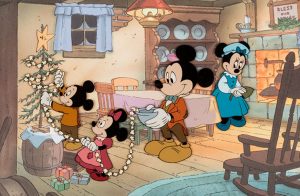 The opening scene of the film was based on one of Carl Barks’ oil paintings titled The Season To Be Jolly.
The opening scene of the film was based on one of Carl Barks’ oil paintings titled The Season To Be Jolly.
Other animation was done by Matthew O’Callaghan, Retta Davidson, Walt Stanchfield, Toby Shelton, and John Lasseter (who worked on Jiminy Cricket and Scrooge soaring over the rooftops and came up with the business of Scrooge scrambling to the top of Jiminy’s open umbrella) but some artists didn’t get credit.
Peraza’s wife, Patty, who did a lot of the effects animation for the film, including snow gusts, fire, shadows and more fell short by about ten feet worth of work to get a screen credit. Mark Dindal did get credit for working on effects and would later go on to be an animation director.
Burny’s wife Sylvia oversaw all the assistants and the final cleanup. Layout was by Peraza, Sylvia Roemer, and Garry Eggleston. Don Griffith also did a lot of initial design work for the film setting the style for the backgrounds.
It was the last theatrical film featuring Clarence Nash at the age of 79 as the voice of Donald Duck and the first theatrical film featuring Wayne Allwine as the voice of Mickey Mouse. Some uncredited voice work was done by Glen Keane, John Lasseter, Mike and Patty Peraza, Mark Henn and Randy Cartwright, who supplied background vocals in some of the crowd scenes.
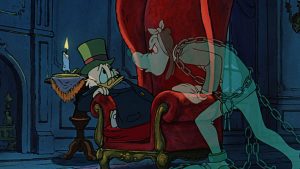 Burny Mattinson and Will Ryan did the voices of the weasels. Ryan also did Pete and went on to do the same character in the television series DuckTales.
Burny Mattinson and Will Ryan did the voices of the weasels. Ryan also did Pete and went on to do the same character in the television series DuckTales.
The film was filled with cameos of classic Disney animated characters (mostly during the Fezziwig dance scene, but also in the street) including The Three Little Pigs, the Big Bad Wolf, Toby Tortoise, Max Hare, Clara Cluck, Gus Goose, Peter Pig, Clarabelle Cow, Horace Horsecollar, Grandma Duck, Chip’n’Dale, Huey, Dewey, Louie, Angus MacBadger, Mr. Toad, The Naboombu Secretary Bird (Bedknobs and Broomsticks), Lady Kluck, Skippy Bunny, Toby Turtle (the last three from Robin Hood), two of the Three Little Wolves, Cyril Proudbottom and two unnamed weasels from The Wind in the Willows, among others.
The film was nominated for an Academy Award for Best Animated Short Film in 1984 but lost to the clay stop motion short Sundae in New York that celebrated New York. It was the first Oscar nomination for a Mickey Mouse short since Mickey and the Seal (1948).
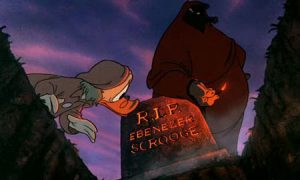 At one point, it was considered making the film a prime-time annual Christmas special on CBS, much like other popular half-hour animated Christmas shows. However, a somewhat lengthy strike during the production of the film seems to have killed that idea.
At one point, it was considered making the film a prime-time annual Christmas special on CBS, much like other popular half-hour animated Christmas shows. However, a somewhat lengthy strike during the production of the film seems to have killed that idea.
At another point, it was discussed about expanding it into a feature film, but top executives felt that the film would only be able to be shown at the holiday season and so would not generate enough income on re-issues.
Ron Miller was interested in the idea of a feature and Mattinson offered suggestions for expansion, including having Scrooge pass a pet store every day on the way to work with an eager Pluto in the window. Scrooge was immune to the dog’s charms but at the end would eventually bring him home to Tiny Tim.
“It came awfully close,” said Mattinson whose dream was an animated feature length film with the Fab Five.
The Black Cauldron (1985) and Mickey’s Christmas Carol were the last animated films to complete production in the original animation studio building in Burbank, before the department was moved to a location in Glendale and the studio reformatted the animation buildings into executive offices. Today, the featurette is considered a “classic” and inspired other featurettes with the Fab Five like The Prince and the Pauper.

And so, as Tiny Tim observed, God bless Us, Every One!


 Jim Korkis is an internationally respected animation historian who in recent years has devoted his attention to the many worlds of Disney. He was a columnist for a variety of animation magazines. With his former writing partner, John Cawley, he authored several animation related books including The Encyclopedia of Cartoon Superstars, How to Create Animation, Cartoon Confidential and Get Animated’s Animation Art Buyer’s Guide. He taught animation classes at the Disney Institute in Florida as well as instructing classes on acting and animation history for Disney Feature Animation: Florida.
Jim Korkis is an internationally respected animation historian who in recent years has devoted his attention to the many worlds of Disney. He was a columnist for a variety of animation magazines. With his former writing partner, John Cawley, he authored several animation related books including The Encyclopedia of Cartoon Superstars, How to Create Animation, Cartoon Confidential and Get Animated’s Animation Art Buyer’s Guide. He taught animation classes at the Disney Institute in Florida as well as instructing classes on acting and animation history for Disney Feature Animation: Florida.




















































Mickey’s Christmas Carol is also a favorite of mine, imo it’s the best of all the Disney versions of A Christmas Carol. Among the other cameos in the short are Uncle Waldo (the male goose from The Aristocats), Mother Rabbit, a couple of squirrels & a raccoon from Robin Hood.
Merry Christmas to Everybody!
Another important contributor to “Mickey’s Christmas Carol” was Disney Legend Irwin Kostal, who composed and conducted the musical score. Kostal had a long career as an arranger and orchestrator in film and television and on Broadway, winning Oscars for his scores to “West Side Story” and “The Sound of Music”. He collaborated with the Sherman brothers on five of their musical films, including “Mary Poppins”, “Bedknobs and Broomsticks” and “Pete’s Dragon”, and he conducted the Dolby stereo soundtrack of “Fantasia” for its re-release in the eighties. Kostal was over seventy when he worked on “Mickey’s Christmas Carol”, and, like Clarence Nash, he retired immediately afterward.
Kostal’s score lacks the sumptuousness and dramatic force of, say, Oliver Wallace, but is nevertheless a solid professional effort, with some effective Mickey-Mousing. Of particular note is the way that Scrooge is associated with the solo bassoon in the early part of the film. The bassoon is often played for comic effect in cartoons, but these mournful solos, without any instrumental accompaniment, express the loneliness at the heart of Scrooge’s misery.
Another cameo: The horse pulling Donald/Fred’s carriage is a dead ringer for the one Ichabod Crane rode in “The Legend of Sleepy Hollow”.
Right picture, wrong horse, Paul. The horse pulling Donald’s carriage was the cameo for Cyril Proudbottom, the Gypsy cart horse from the “Mr. Toad” element of “Ichabod and Mr. Toad”.
“Mickey’s Christmas Carol” is one of my favorite Christmas cartoons. It’s probably my favorite adaptation of any kind of “A Christmas Carol.” Everything about it works: the story, the animation, Irwin Kostal’s music and the casting of the Disney characters. I also love the opening song “Oh, What a Merry Christmas Day.”
By the way, Will Ryan also voiced Willie the Giant and Hal Smith voiced Goofy and Ratty.
This version is watchable for me no matter what everyone says.
The definitive animated “Christmas Carol” will always be the Richard Williams, with Mister Magoo a close second.
I just watched it last night. I would have preferred a longer version for longer visits with the ghosts. But, it is quite entertaining just the way it is. Thanks for the informative article on a great cartoon!
Burny told me that he wanted to use all the songs by Tom and Frances Adair from the original albums (which I have written about in two previous Cartoon Research posts) but Ron Miller nixed them. Also, even though Alan Young wrote the script, he was not originally called in for casting as Uncle Scrooge. He told me that a fellow actor mentioned that Disney was using his script for casting sessions for Mickey’s Christmas Carol, so Young approached Disney himself. He was told that they did not think he would have been interested. Of course he was, he got the part using his true Scotish accent and played Scrooge for the next several decades on records, films and theme parks.
Yes but its a shame we’ll never receive a blu-ray of this kind in a few years.
It’s a beautiful cartoon.
it is a really good cartoon
The presentation of this film on Disney + is really poor. The 4:3 picture is cropped to fill modern screens and either they applied a heavy filter that smoothes the lines too much and make everything blurry or it is low definition blown to HD. Does someone know where a proper HD, not messed with version can be seen?
That same DVNR’ed transfer was actually used first on the “30th Anniversary” Blu-Ray back in 2013, it’s not a recent transfer for Disney Plus.
As for the widescreen “cropping”, most Disney cartoon films produced at this time were animated with both full screen and widescreen presentations in mind, meaning the film is technically open matte.
(The 2004 “Mickey Mouse in Living Color” DVD version of MCC was at least mildly cropped in the 1.66:1 aspect ratio; the Blu-Ray and Disney Plus release is 1.78:1. Why Disney didn’t stick with the milder theatrical OAR, I don’t know).
“At one point, it was considered making the film a prime-time annual Christmas special on CBS, much like other popular half-hour animated Christmas shows. However, a somewhat lengthy strike during the production of the film seems to have killed that idea.”
I read that this was a major factor reason Disney had to put together a holiday compilation special (which some of you may know as “A Disney Christmas Gift”) for their Walt Disney program that was airing on CBS at the time.
There were some merchandise for the short that came out as early as 1982 that included a re-release of the 1974 story record now modified and retitled under the “Mickey’s Christmas Carol” name.
Eventually a “special” of MCC DID come out a year after it’s theatrical release, originally airing NBC (which collected 3 other Disney Christmas/winter themed shorts: “Donald’s Snow Fight”, “The Art of Skiing”, and “Pluto’s Christmas Tree”). This special had bumpers that were drawn in the same style as the film’s opening title cards, also done by Mike Peraza. This is the version that would also air on CBS and ABC (minus the Goofy short).
I think that right now the best version of this short film in HD is available in “Mickey’s Magical Christmas: Snowed in at the House of Mouse” in Amazon Prime. The short is shown in full, but without the opening and end credits. It’s a beautiful print, with the grain mostly intact and in 4:3. Definitely, my favourite way of watching it at the moment, until a proper 4K HDR restoration appears in Disney + (if ever).
I never knew Frank and Ollie remarked about Ratty and Moley. Thanks for mentioning that.
I was honored to be the solo bassoonist on the sound track. It was a day I will never forget.
It was indeed an honor to be the solo bassoonist on the soundtrack of Mickey’s Christmas Carol.
John Campbell